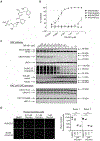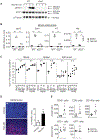A small-molecule SUMOylation inhibitor activates antitumor immune responses and potentiates immune therapies in preclinical models
- PMID: 34524860
- PMCID: PMC9719791
- DOI: 10.1126/scitranslmed.aba7791
A small-molecule SUMOylation inhibitor activates antitumor immune responses and potentiates immune therapies in preclinical models
Abstract
SUMOylation, the covalent conjugation of small ubiquitin-like modifier (SUMO) proteins to protein substrates, has been reported to suppress type I interferon (IFN1) responses. TAK-981, a selective small-molecule inhibitor of SUMOylation, pharmacologically reactivates IFN1 signaling and immune responses against cancers. In vivo treatment of wild-type mice with TAK-981 up-regulated IFN1 gene expression in blood cells and splenocytes. Ex vivo treatment of mouse and human dendritic cells promoted their IFN1-dependent activation, and vaccination studies in mice demonstrated stimulation of antigen cross-presentation and T cell priming in vivo. TAK-981 also directly stimulated T cell activation, driving enhanced T cell sensitivity and response to antigen ex vivo. Consistent with these observations, TAK-981 inhibited growth of syngeneic A20 and MC38 tumors in mice, dependent upon IFN1 signaling and CD8+ T cells, and associated with increased intratumoral T and natural killer cell number and activation. Combination of TAK-981 with anti-PD1 or anti-CTLA4 antibodies improved the survival of mice bearing syngeneic CT26 and MC38 tumors. In conclusion, TAK-981 is a first-in-class SUMOylation inhibitor that promotes antitumor immune responses through activation of IFN1 signaling. TAK-981 is currently being studied in phase 1 clinical trials (NCT03648372, NCT04074330, NCT04776018, and NCT04381650) for the treatment of patients with solid tumors and lymphomas.
Figures







References
-
- Hargadon KM, Johnson CE, Williams CJ, Immune checkpoint blockade therapy for cancer: An overview of FDA-approved immune checkpoint inhibitors. Int. Immunopharmacol 62, 29–39 (2018). - PubMed
-
- Galon J, Bruni D, Approaches to treat immune hot, altered and cold tumours with combination immunotherapies. Nat. Rev. Drug Discov 18, 197–218 (2019). - PubMed
-
- Lee C-K, Rao DT, Gertner R, Gimeno R, Frey AB, Levy DE, Distinct requirements for IFNs and STAT1 in NK cell function. J. Immunol 165, 3571–3577 (2000). - PubMed
Publication types
MeSH terms
Grants and funding
LinkOut - more resources
Full Text Sources
Other Literature Sources
Molecular Biology Databases
Research Materials
Miscellaneous

